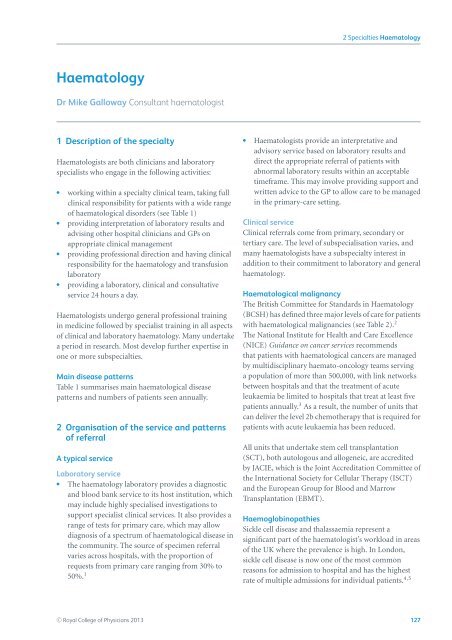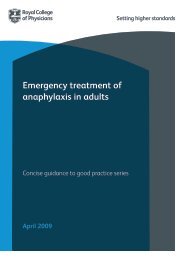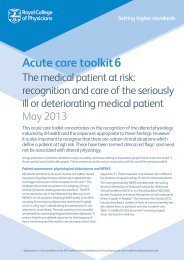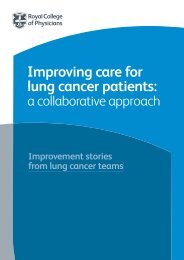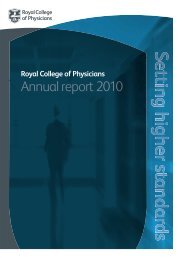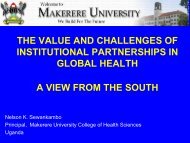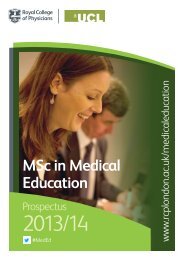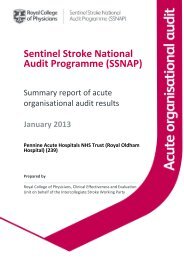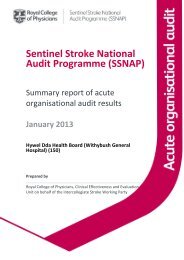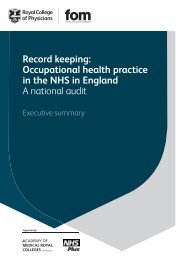Consultant physicians working with patients - Royal College of ...
Consultant physicians working with patients - Royal College of ...
Consultant physicians working with patients - Royal College of ...
Create successful ePaper yourself
Turn your PDF publications into a flip-book with our unique Google optimized e-Paper software.
2 Specialties HaematologyHaematologyDr Mike Galloway <strong>Consultant</strong> haematologist1 Description <strong>of</strong> the specialty Haematologists provide an interpretative andadvisory service based on laboratory results andHaematologists are both clinicians and laboratorydirect the appropriate referral <strong>of</strong> <strong>patients</strong> <strong>with</strong>specialists who engage in the following activities:abnormal laboratory results <strong>with</strong>in an acceptabletimeframe. This may involve providing support and <strong>working</strong> <strong>with</strong>in a specialty clinical team, taking full written advice to the GP to allow care to be managedclinical responsibility for <strong>patients</strong> <strong>with</strong> a wide range in the primary-care setting.<strong>of</strong> haematological disorders (see Table 1) providing interpretation <strong>of</strong> laboratory results and Clinical serviceadvising other hospital clinicians and GPs on Clinical referrals come from primary, secondary orappropriate clinical managementtertiary care. The level <strong>of</strong> subspecialisation varies, and providing pr<strong>of</strong>essional direction and having clinical many haematologists have a subspecialty interest inresponsibility for the haematology and transfusion addition to their commitment to laboratory and generallaboratoryhaematology. providing a laboratory, clinical and consultativeservice 24 hours a day.Haematological malignancyThe British Committee for Standards in HaematologyHaematologists undergo general pr<strong>of</strong>essional training (BCSH) has defined three major levels <strong>of</strong> care for <strong>patients</strong>in medicine followed by specialist training in all aspects <strong>with</strong> haematological malignancies (see Table 2). 2<strong>of</strong> clinical and laboratory haematology. Many undertake The National Institute for Health and Care Excellencea period in research. Most develop further expertise in (NICE) Guidance on cancer services recommendsone or more subspecialties.that <strong>patients</strong> <strong>with</strong> haematological cancers are managedby multidisciplinary haemato-oncology teams servingMain disease patternsa population <strong>of</strong> more than 500,000, <strong>with</strong> link networksTable 1 summarises main haematological disease between hospitals and that the treatment <strong>of</strong> acutepatterns and numbers <strong>of</strong> <strong>patients</strong> seen annually. leukaemia be limited to hospitals that treat at least five<strong>patients</strong> annually. 3 As a result, the number <strong>of</strong> units thatcan deliver the level 2b chemotherapy that is required for2 Organisation <strong>of</strong> the service and patterns <strong>patients</strong> <strong>with</strong> acute leukaemia has been reduced.<strong>of</strong> referralAll units that undertake stem cell transplantationA typical service(SCT), both autologous and allogeneic, are accreditedby JACIE, which is the Joint Accreditation Committee <strong>of</strong>Laboratory service the International Society for Cellular Therapy (ISCT)The haematology laboratory provides a diagnosticand the European Group for Blood and Marrowand blood bank service to its host institution, whichTransplantation (EBMT).may include highly specialised investigations tosupport specialist clinical services. It also provides aHaemoglobinopathiesrange <strong>of</strong> tests for primary care, which may allowSickle cell disease and thalassaemia represent adiagnosis <strong>of</strong> a spectrum <strong>of</strong> haematological disease insignificant part <strong>of</strong> the haematologist’s workload in areasthe community. The source <strong>of</strong> specimen referral<strong>of</strong> the UK where the prevalence is high. In London,varies across hospitals, <strong>with</strong> the proportion <strong>of</strong>sickle cell disease is now one <strong>of</strong> the most commonrequests from primary care ranging from 30% toreasons for admission to hospital and has the highest50%. 1 rate <strong>of</strong> multiple admissions for individual <strong>patients</strong>. 4,5C○ <strong>Royal</strong> <strong>College</strong> <strong>of</strong> Physicians 2013 127


